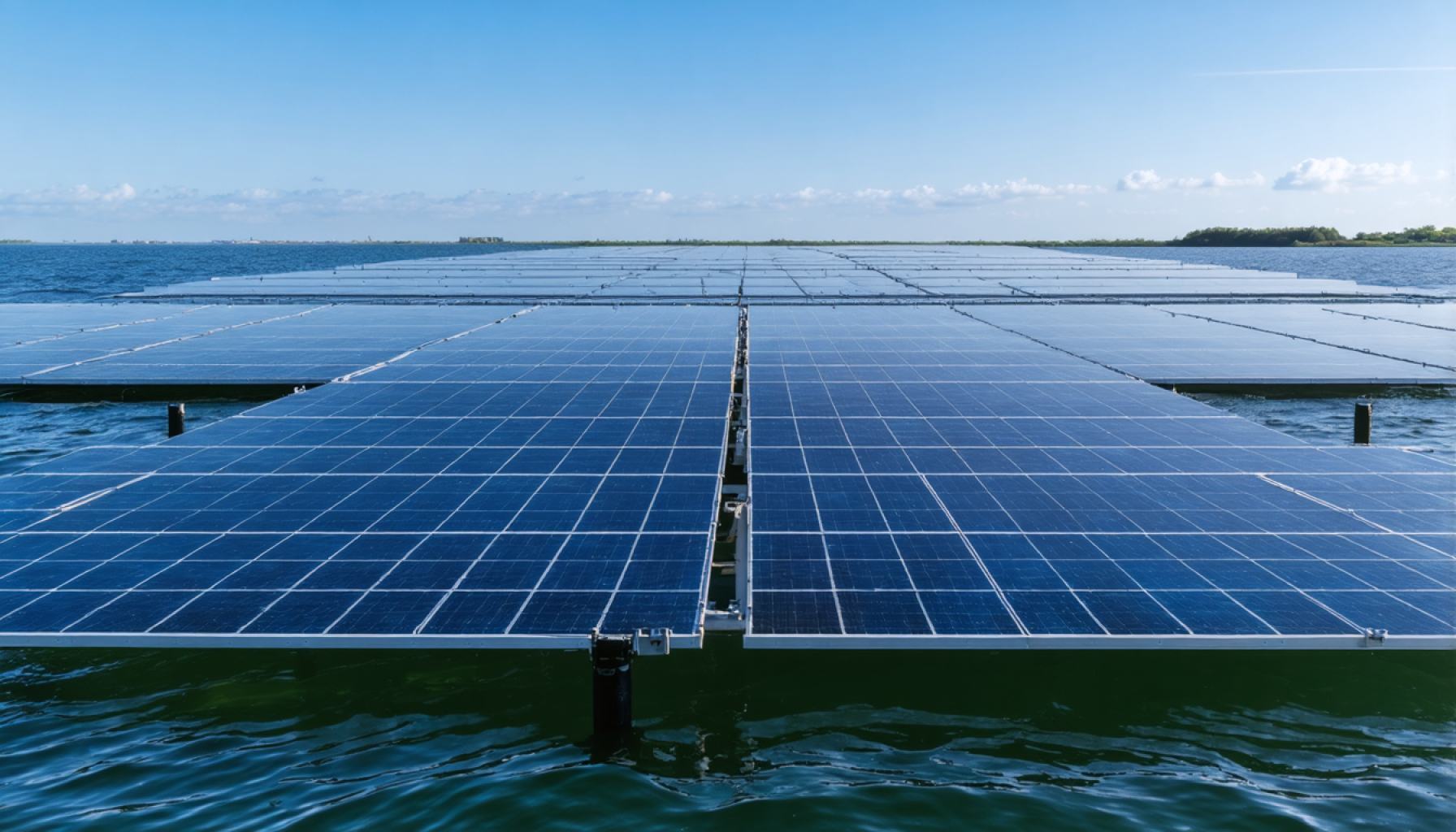- Floating solar farms provide a viable solution to land limitations faced by traditional solar installations, utilizing bodies of water for energy generation.
- The Alqueva reservoir in Portugal hosts one of Europe’s largest floating solar farms, contributing to both energy production and water conservation.
- By shading water surfaces, floating solar panels reduce evaporation and enhance panel efficiency through natural cooling.
- These installations sustain aquatic ecosystems by stabilizing temperatures, promoting biodiversity under climate stress.
- Challenges include high installation costs and maintenance difficulties in unstable waters, but technological advances are reducing costs.
- Floating solar farms represent a paradigm shift in renewable energy, optimizing water-use efficiency and conserving land resources.
- This innovation heralds a sustainable future where water bodies become key players in electricity generation, supporting ecological balance.
Glistening under the sun, a sea of solar panels floats serenely on a lake’s surface, transforming ordinary bodies of water into powerhouses of renewable energy. As traditional land-based solar farms face space limitations and environmental concerns, innovative floating solar farms emerge on the global stage, offering a compelling solution to balancing the energy equation.
Venture into the heart of rural Portugal, and you’ll find a breathtaking scene: thousands of solar panels swaying gently with the water’s rhythm, part of one of Europe’s largest floating solar farms. The Alqueva reservoir, known more for its tranquil reflections than technological advances, now orchestrates a silent symphony of sustainability. Reflecting both sunlight and ambition, these panels not only capture solar energy but also reduce evaporation from the reservoir, acting as a shield against the relentless sun.
Experts champion floating solar farms for their dual-purpose approach. By conserving land, they address critical shortages and avoid disruptions to agriculture. Simultaneously, the water beneath keeps the panels cool, heightening efficiency and energy yield. Imagine generating electricity from the sun while preserving precious water resources; floating solar farms achieve just that.
Yet, the impact extends beyond energy production. By providing shade, these installations help sustain aquatic ecosystems under stress from climate change. Fish thrive as temperatures stabilize, creating a ripple effect that benefits biodiversity.
While the allure of floating solar farms grows, challenges remain. Installation costs can soar, and in unstable waters, maintenance poses hurdles. However, with technological advancements and economies of scale, costs continue to fall, paving the way for broader adoption.
Floating solar farms like those in Alqueva aren’t just reshaping landscapes; they’re revolutionizing how we think about renewable energy. Picture a future where lakes, reservoirs, and even dams become bustling centers of electricity generation, illuminating millions of homes while protecting the planet’s finite resources.
The takeaway? Floating solar farms symbolize a leap forward in our quest for sustainable energy solutions, illustrating that innovation intertwined with nature can fuel a brighter, greener future. Embrace the wave of progress as solar panels ripple across the water, unlocking endless possibilities.
Unveiling the Future of Renewable Energy: Why Floating Solar Farms Are Game Changers
Floating solar farms are not merely a futuristic concept but a rapidly advancing innovation in the renewable energy sector. These installations, gently resting on the surfaces of water bodies, have garnered significant attention for their potential to transform how we generate electricity. Let’s dive deeper into the benefits, challenges, and future prospects of floating solar farms.
Advantages of Floating Solar Farms
1. Land Conservation: By occupying water surfaces instead of land, floating solar farms save valuable terrestrial space, which can be utilized for agriculture, housing, and preserving natural habitats.
2. Increased Efficiency: Water’s natural cooling effect reduces the temperature of solar panels, enhancing their efficiency and leading to higher energy yields compared to land-based installations.
3. Water Resource Management: Floating solar installations reduce evaporation rates in water bodies, conserving precious water resources. This is particularly crucial in arid and semi-arid regions.
4. Aquatic Ecosystem Benefits: The shade provided by solar panels stabilizes water temperatures, creating a conducive environment for aquatic life and aiding biodiversity.
5. Reducing Algal Blooms: By limiting sunlight penetration, floating panels can also help control the growth of algae, which can disrupt aquatic ecosystems.
Challenges and Limitations
1. High Installation Costs: Initial setup costs for floating solar farms remain higher than land-based systems due to the need for specialized materials and technology.
2. Maintenance Concerns: Operating in a water environment poses unique maintenance challenges. Issues such as corrosion, water access, and biofouling require innovative solutions.
3. Structural Stability: High winds and waves in open water bodies can threaten the stability of these installations, necessitating robust design and engineering.
Industry Trends and Future Prospects
Floating solar technology is still in its early stages compared to its terrestrial counterpart. However, technological advancement and decreasing costs promise a bright future. The global market for floating solar is expected to grow significantly. According to the International Renewable Energy Agency (IRENA), floating PV has the potential to reach a global capacity of 400 GW by 2030.
Key Insights and Recommendations
– Integrating Other Renewable Sources: Combining solar farms with hydropower installations can maximize energy production and smooth out supply fluctuations, making it a dual-benefit solution.
– Policy Support: Governments can play a pivotal role by offering incentives, subsidies, and regulatory support to bolster the adoption of floating solar technologies.
– Corporate Engagement: Companies looking to invest in clean energy should consider floating solar as part of their sustainability initiatives, given its dual benefits to energy and the environment.
– Innovative Financing Models: New financing models, such as green bonds and community investment schemes, can facilitate the investment needed to scale up floating solar technologies.
Real-World Use Cases
Countries like China, India, Japan, and South Korea are leading the charge in floating solar installations. For example, China has launched several large-scale projects, like the Anhui Province installation, which boasts an impressive capacity of over 150 MW.
Quick Tips for Investors and Stakeholders
– Assess Local Conditions: Before investing, assess the local climatic and environmental conditions to ensure suitability for floating solar installations.
– Partner with Experts: Collaborate with engineering and renewable energy experts to address design, maintenance, and operational challenges.
– Monitor Technological Advances: Stay informed about new materials and technologies that can lower costs and improve efficiency.
For those looking to bolster their sustainable energy portfolios, floating solar farms offer a robust and innovative solution. Discovering how water bodies can be converted into energy hubs might just be the next big leap in our journey toward a sustainable future.
Explore more about sustainable solutions at International Renewable Energy Agency (IRENA).
















